Saffron Walden
| Saffron Walden | |
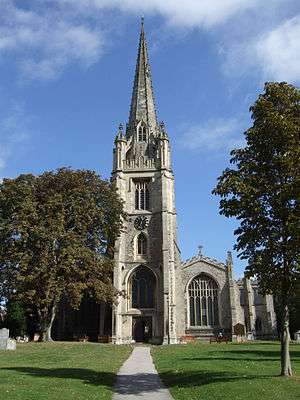 St Mary the Virgin, Saffron Walden |
|
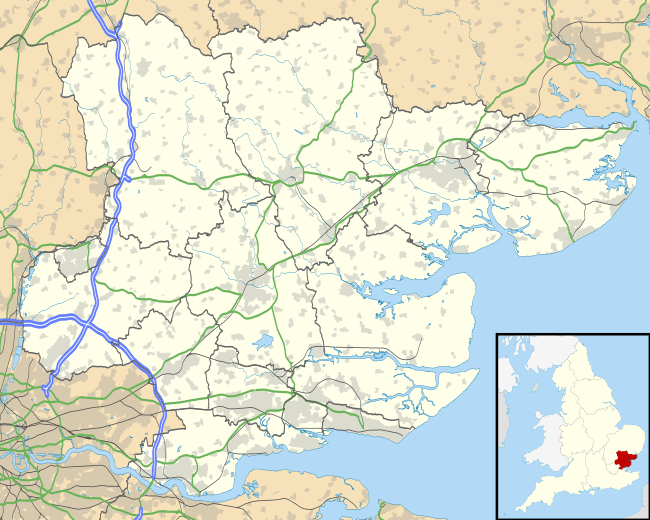 Saffron Walden |
|
| Population | 15,504 (2011)[1] |
|---|---|
| OS grid reference | TL541387 |
| District | Uttlesford |
| Shire county | Essex |
| Region | East |
| Country | England |
| Sovereign state | United Kingdom |
| Post town | SAFFRON WALDEN |
| Postcode district | CB10-11 |
| Dialling code | 01799 |
| Police | Essex |
| Fire | Essex |
| Ambulance | East of England |
| EU Parliament | East of England |
| UK Parliament | Saffron Walden |
Coordinates: 52°01′19″N 0°14′35″E / 52.022°N 0.243°ESaffron Walden is a market town in the Uttlesford district of Essex, England. It is 12 miles (19 km) north of Bishop's Stortford, 18 miles (29 km) south of Cambridge and 43 miles (69 km) north of London. The town retains a rural appearance and has buildings dating from the medieval period onwards. In 2001 the parish had a population of 14,313, which had increased to 15,504 by the 2011 census.[1]
History
Archaeological evidence suggests continuous settlement on or near the site of Saffron Walden from at least the Neolithic period.[2] It is believed that a small Romano-British settlement and fort – possibly in the area around Abbey Lane – existed as an outpost of the much larger settlement of Cestreforda to the north.[2]
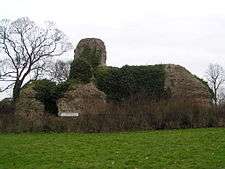
After the Norman invasion of 1066, a stone church was built. Walden Castle dates from around 1140. It may have been built on a pre-existing fortification.[3] A priory, Walden Abbey, was founded under the patronage of Geoffrey de Mandeville, first Earl of Essex around 1136 on the site of what is now Audley End village.[2] The abbey was separated from the town of Walden by Holywell Field. After the dissolution of the monasteries, Sir Thomas Audley converted the abbey cloisters into a dwelling. Later this would become the site of Audley End House.[2]
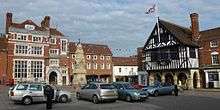
The market was moved from nearby Newport to Saffron Walden during de Mandeville's tenure, increasing the town's influence. The Tuesday market operated from 1295.[2] The town’s first charter was granted in around 1300, to what was known then as Chepyng Walden, meaning Market Walden.[2] The town was largely confined to the castle's outer bailey, but in the 13th century the Battle or Repel Ditches were built or extended to enclose a larger area to the south. The focus of the town moved southwards to Market Square.
In the medieval period the primary trade was in wool and a guild hall was built by the wool-staplers in the market place. It was demolished in 1847 and replaced by a corn exchange.[2] In the 16th and 17th centuries the saffron crocus (Crocus sativus) was widely grown, thanks to the town's favourable soil and climate. The flower was precious, as the extract from the stigmas was used in medicines, as a condiment, in perfume, as an aphrodisiac, and as an expensive yellow dye. The industry gave Walden its name.[2]

Puritans and Quakers
The town and surrounding area, like much of East Anglia, was strongly Puritan during the 17th century. The population was influenced by the missionary John Eliot. By 1640, Samuel Bass's family and a number of others had departed for the Massachusetts Bay Colony as part of the Great Migration.[4]
Saffron Walden was at the centre of the Eastern Association during the English Civil War. While the town was the headquarters of the New Model Army, Lieutenant-General of Horse, Oliver Cromwell paid a 19-day visit in May 1647, participating in debates to seek a settlement between Parliament and the army.[5] He is reputed to have stayed at the Sun Inn.[6]
By the end of the 18th century the saffron flower was no longer in demand, and the industry was replaced by malt and barley. More than 40 maltings stood in the town at the end of the century.[7] The trade was not so lucrative as saffron but the town continued to grow throughout the 19th century and had a cattle market, corn exchange and other civic buildings. During this time Quakers became active; the most influential family, the Gibsons – one of the founding families of Barclays Bank – aided the construction of several public buildings that remain today, such as the museum and town hall.[8][9]
In the 1900s the Saffron Walden branch railway line from Audley End station, on the mainline from London to Cambridge, was extended to Bartlow. The branch closed in the Beeching cuts in the 1960s.[10] Heavy industry arrived after the Second World War. Acrows Ltd, makers of falsework, built premises to the east of the town and became a significant employer and economic influence in the area.[11] For a short time there was a dedicated railway station for the works known as Acrow Halt.[12] Light industry was added to the south of the town at Shire Hill. As the agricultural economy continued to mechanise, the new-found employment opportunities were welcome and a period of migration into the town from surrounding villages led to major expansion of housing estates in the 1970s and 1980s.
Coat of arms and maces
Saffron Walden's unofficial coat of arms showed the saffron crocus within the walls of the castle in the form of an heraldic pun – as in, "Saffron walled-in". In 1961, a formal coat of arms was granted by the College of Arms and this was adapted in 1974 into its current form.[13]
The town has three ceremonial maces. The large mace was given to Saffron Walden by James II in 1685 and provides an early recording of the unofficial coat of arms. Made of silver gilt, it is approximately 4 feet (1.2 m) long. Two smaller silver maces were bought by the corporation in 1549 to commemorate the granting of a new town charter by Edward VI. This purchase is recorded in the town's Guild of Holy Trinity accounts and reads, "For 2 new maces, weying 18 ownces one quarter and half at 8s. the ownce 7l.7s".[13]
Sites and buildings of interest

The 12th-century Walden Castle, built or expanded by Geoffrey de Mandeville, the first Earl of Essex is in ruins. After the medieval period, the castle fell into disuse and much of the flint was taken and used in the construction of local houses and the wall surrounding the Audley End estate. All that remains is the ruined basement.
Near to the castle is a turf maze, a series of circular excavations cut into the turf of the common. It is the largest example of this style of maze in England, the main part is about 100 feet (30 m) in diameter. The earliest record of it dates from 1699, although its origin may be earlier. It has been extensively restored several times, most recently in 1979.[14][15]
The oldest inhabited building in the town is believed to be the former maltings at 1 Myddleton Place. The 15th-century building with a courtyard garden was used by the Youth Hostel Association from 1947 to 2010.[16] It is now used for functions.[17] Pevsner described it as: "without doubt, the best medieval house of Saffron Walden".[18] Other notable early buildings are in Bridge Street, Castle Street and the side streets off the High Street. The High Street contains some late-Georgian and Victorian buildings.[18]
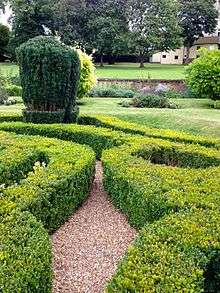
Bridge End Gardens, seven interlinked gardens – including a maze, rose garden and walled garden – was originally laid out by the Gibson family. They have been restored with help from the Heritage Lottery Fund and volunteers.[19][20]
St Mary the Virgin, Saffron Walden is the largest parish church in Essex.[21] The church dates mainly from the end of the 15th century, when an old smaller church was extensively rebuilt by the master mason John Wastell who was building King's College Chapel in the nearby city of Cambridge. In 1769 it was damaged by lightning and the repairs, carried out in the 1790s, removed many medieval features. The spire was added in 1832 to replace an older "lantern" tower. The church is 183 feet (56 m) long and the spire, 193 feet (59 m) high, is the tallest in Essex.
The town's Catholic church, Our Lady of Compassion, is on Castle Street. Created in 1906 from a 16th-century barn, it was restored in 2004-5.[22] With a long history of non-conformism, Saffron Walden has a Baptist church and a Quaker meeting house. There is a United Reformed Church on Abbey Lane, a Methodist church on Castle Street and the independent Gold Street Chapel on Gold Street.[23]
Governance
The town is administered by Saffron Walden Town Council which has 16 members. The majority party is Residents for Uttlesford (R4U), formed by local residents' groups. The main opposition is the Conservative Party.[24] The Liberal Democrats and Labour are also represented. As of 2015, the mayor is Heather Asker of Residents for Uttlesford and the Acting Town Clerk is Malcolm White.[25] The town is divided into three wards: Audley – named after Audley End House – represents the western area of Saffron Walden including Audley End; Castle takes its name from Saffron Walden Castle and includes Little Walden and the large rural area north of the town; Shire (formerly Plantation) represents the southern area of the town.
The town's MP, for its eponymous Westminster constituency, has been Sir Alan Haselhurst since a by-election in 1977. Sir Alan was Chairman of Ways and Means and Deputy Speaker from 1997 to 2010. It has been considered a safe seat for the Conservative Party since 1922.
Demography
According to the Office for National Statistics, at the time of the United Kingdom Census 2001, Saffron Walden had a population of 14,313. The 2001 population density was 10,900 inhabitants per square mile (4,209/km2), with a 100 to 94.5 female-to-male ratio.[26] Of those over 16 years old, 45.0% were married, 27.4% were single (never married), and 8.2% divorced.[27] The parish's 6,013 households included 38.5 per cent married couples living together, 31.5 per cent one-person households, 8.4 per cent co-habiting couples, and 7.9 per cent single parents with children.[28] Of those aged 16–74, 22.3 per cent had no academic qualifications, close to the average for Uttlesford (22.0 per cent) and below that for the whole of England (28.9 per cent).[29][30]
In the 2001 UK census, 73.0 per cent of Saffron Walden residents declared themselves Christian, 0.6 per cent Muslim, 0.4 per cent Buddhist, 0.2 per cent Jewish, and 0.1 per cent Hindu. The census recorded 17.6 per cent as having no religion, 0.4 per cent with an alternative religion, and 7.8 per cent not stating their religion.[31]
Education
Saffron Walden County High School is a large co-educational academy with over 2000 pupils.[32] Located to the west of the town centre, it was rated outstanding in its most recent Ofsted report in 2012.[33] The school replaced Saffron Walden Grammar School, which was established in 1521 by the town's Holy Trinity Guild and Dame Joan Bradbury, a local benefactor.[2] Friends' School is a co-educational Quaker independent school with roots dating back to 1702. The current building, in Mount Pleasant Road, opened in 1879.[34] Saffron Walden College, a teachers' training college for women, closed in 1977.[35]
Transport
Saffron Walden is served by Audley End railway station, which is located 2 miles (3 km) outside the town in the village of Wendens Ambo, with regular bus services to the town centre. The station is on the West Anglia mainline service between Cambridge and London Liverpool Street Station, with an off-peak service of two trains an hour, southbound and northbound, and more services during peak times. The journey time to London is about 55 minutes. All southbound trains also stop at Tottenham Hale station, where there is a London Underground Victoria Line station and onward rail connections to Stratford station in east London. The journey to Cambridge station from Audley End takes under 20 minutes. An hourly CrossCountry service between Stansted Airport and Birmingham New Street via Peterborough and Leicester also stops at Audley End.
Saffron Walden is accessed from junction 8 of the M11 travelling from London (a distance of about 15 miles (24 km)) and from junction 10 travelling from the Cambridge direction (8 miles (13 km)). Stansted Airport is some 15 miles (24 km) from the town, while Luton Airport is 43 miles (69 km) away.
Regular bus services connect the town with Cambridge, Bishop's Stortford, Haverhill and Stansted Airport.
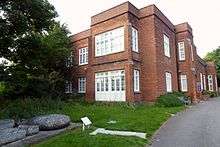
Culture
Audley End House – once one of the largest mansions in England – is now in the care of English Heritage and open to the public.[36] During the summer months, picnic concerts and a last night in the style of the BBC Proms are held in the grounds.[37][38] Audley End Miniature Railway – originally built by Lord Braybrooke – is a 10 1⁄4 in (260 mm) gauge railway ride through woodland adjoining Audley End House. The track is 1.5 miles (2.4 km) long and opened in 1964.[39]
Saffron Walden Museum, which was established in 1835 by Saffron Walden Natural History Society, is close to the town castle. The museum had many benefactors from local families, including the Gibsons, Frys and Tukes. The first professional curator Guy Nathan Mayard, was appointed in 1889 and his son, also Guy Maynard, succeeded him as curator before moving on to Ipswich Museum. It is still owned by the founding society – now Saffron Walden Museum Society – and is managed by Uttlesford District Council.[40] The museum contains the stuffed remains of a lion named Wallace(1812 – 1838), said to have inspired Marriott Edgar's comic poem "The Lion and Albert".[41]
The Fry Art Gallery exhibits the work of artists who had an association with Saffron Walden and north west Essex, focusing on Great Bardfield Artists. The collection includes extensive artworks and supporting material by Edward Bawden, who lived in the town during the 1970s and 1980s, and Eric Ravilious.[42]
Saffron Hall, which is attached to Saffron Walden County High School, opened in 2013. The 730-seater venue came about as a result of a £10 million donation by an anonymous music loving donor.[32] In 2014, former head of music at the Barbican Centre Angela Dixon became its director.[43]
Sport and leisure
The Anglo American playing fields, located close to Bridge End Gardens on Caton Lane, are home to the town's cricket club and were donated to Saffron Walden by the US Forces after the war. Prior to that, Saffron Walden Cricket Club played on the town's common – with a history of cricket matches recorded back to 1757.[44] A monument at the site commemorates the American airmen and people of Saffron Walden who died in the Second World War.[45][46]
Saffron Walden has a non-league football club Saffron Walden Town F.C., which also plays at Catons Lane. There is also a rugby club and a long-distance running and triathlon team. Lord Butler Leisure Centre is located on Peaslands Road and includes a pool, gym and sports injury clinic.[47] The Tour de France passed through Saffron Walden in 2014.[48]
Saffron Walden has a well-established hockey club with its main pitch and clubhouse in Newport and a second pitch at Saffron Walden County High School. The club has eight men's teams, seven women's teams and a large junior section. The women play in Prem A, which is one division below National League and the men play in Prem B. The town's skate park is an American-built facility.[49] It opened in 2007.[50]
Saffron Walden in music
Saffron Walden is the name of a tune often associated with the hymn Just as I am. It was written by Arthur Henry Brown (1830–1926) from Essex.[51] He wrote many hymn tunes, which he often named after his favourite places.[52]
Notable residents
- Edward Bawden, artist, resident 1970–1989 at 2 Park Lane Studio[53]
- Stig Blomqvist and Tom Blomqvist, racing drivers[54]
- Elizabeth Butchill (c. 1758—1780), hanged for infanticide, a native of the town[55]
- Jack Cardiff, Oscar-winning cinematographer, lived at 7a High Street.[9][53]
- Charles Dunstone, co-founder and chair of Carphone Warehouse and chair of TalkTalk Group[56]
- James Gapes (1822–1899), former mayor of Christchurch, New Zealand[57]
- George Stacey Gibson (1813–1893), botanist, banker and philanthropist, lived at Hill House, High Street.[53]
- Gabriel Harvey, scholar and writer, born 1552/3, lived at 13–17 Gold Street.[53]
- Imogen Heap, musician, was a boarder at Friends' School.[58]
- Gordon Jacob, composer, resident 1959–1984, lived at 1 Audley Road and was at one time president of Saffron Walden and District Music Club[53][59]
- Hattie Jacques, actor, died in 1980.
- Jeff Hordley, actor, Cain Dingle in Emmerdale[60]
- Ian Lavender, actor, best known as Pike in Dad's Army, lived in the town until 2001.[61]
- Stephen McGann, actor[62]
- Jojo Moyes, romantic fiction author[63]
- Clare Mulley, biographer[64]
- Sarah Ockwell-Smith – childcare author.
- Tom Robinson, singer-songwriter, attended Friends' School 1961–1967.[65]
- Sir Thomas Smith, scholar and diplomat, born 1513[66]
- Stan Stammers, songwriter and musician, formerly of UK Subs[67]
- William Strachey, historian, born 1572[68]
- Heidi Thomas, TV and film screenwriter[62]
- Raymond Williams, cultural critic, divided his time between Saffron Walden and Wales in later life.[69]
- Henry Winstanley (1644—1703), creator of the first Eddystone Lighthouse, born in nearby Littlebury and lived at 5 Museum Street.[53]
- Diana Wynne Jones, author, attended Friends School, 1946–1952[70]
Twin towns
Saffron Walden is twinned with:
See also
References
- 1 2 "Town population 2011". Neighbourhood Statistics. Civil Parish population 2011. Retrieved 27 September 2015.
- 1 2 3 4 5 6 7 8 9 "Saffron Walden". recordinguttlesfordhistory.org. The Recorders of Uttlesford History. Retrieved 24 August 2014.
- ↑ "Saffron Walden Castle". www.gatehouse-gazetteer.info. Gatehouse Gazetteer. Retrieved 24 August 2014.
- ↑ Thompson, Roger, Mobility & Migration, East Anglian Founders of New England, 1629–1640, Amherst: University of Massachusetts Press, 1994, p. 20.
- ↑ Coward, Barry (1991). Cromwell: Profiles in Power. Harlow, Essex: Pearson Education. p. 49. ISBN 0582437512. Retrieved 24 August 2014.
- ↑ "The Old Sun Inn, Saffron Walden". vam.ac.uk. Victoria and Albert Museum. Retrieved 25 August 2014.
- ↑ "Saffron Walden Conservation Area Appraisal and Management Proposals, 2012". www.uttlesford.gov.uk. Uttlesford District Council. Retrieved 24 August 2014.
- ↑ "History of Saffron Walden Town Library". townlib.org.uk. Retrieved 24 August 2014.
- 1 2 "Oscar-winning cameraman's Saffron Walden home goes up for sale". Saffron Walden Reporter. 30 September 2013. Retrieved 24 August 2014.
- ↑ "Station name: Saffron Walden". disused-stations.org.uk. Disused Stations. Retrieved 24 August 2014.
- ↑ "History". leadacrow.com. Leada Acrow. Retrieved 24 August 2014.
- ↑ "Station name: Acrow Halt". disused-stations.org.uk. Disused Stations. Retrieved 24 August 2014.
- 1 2 "Civic Regalia". saffronwalden.gov.uk. Saffron Walden Council. Retrieved 24 August 2014.
- ↑ "Saffron Walden". megalithic.co.uk. The Megalithic Portal. Retrieved 24 August 2014.
- ↑ "Saffron Walden Labrynth Photographs". uea.ac.uk. University of East Anglia. Retrieved 24 August 2014.
- ↑ "Hostel to close after losses, says YHA". Cambridge Evening News. 17 June 2010. Retrieved 24 August 2014.
- ↑ "One Myddylton Place". onemyddyltonplace. One Myddylton Place. Retrieved 24 August 2014.
- 1 2 Pevsner, Nikolaus; Radcliffe, Enid (1954). Essex (1965 ed.). London: Penguin Books. p. 335. ISBN 0140710116.
- ↑ "Bridge End Gardens". english-heritage.org.uk. English Heritage. Retrieved 23 August 2014.
- ↑ "Project snapshot". hlf.org.uk. Heritage Lottery Fund. Retrieved 24 August 2014.
- ↑ History and Guides, stmaryssaffronwalden.org, accessed 11/09/2016
- ↑ "Saffron Walden: Our Lady of Compassion". olcsaffronwalden.org.uk. Our Lady of Compassion. Retrieved 25 August 2014.
- ↑ "Church Links". ctsw.org. Churches Together in Saffron Walden. Retrieved 25 August 2014.
- ↑ "Saffron Walden Town Council". saffronwalden.gov.uk. Saffron Walden Town Council. Retrieved 20 May 2015.
- ↑ "The mayor of Saffron Walden". saffronwalden.gov.uk. Saffron Walden Town Council. Retrieved 20 May 2015.
- ↑ "KS01 Usual resident population: Census 2001, Key Statistics for urban areas". Statistics.gov.uk. 7 February 2005. Retrieved 25 July 2011.
- ↑ "KS04 Marital status: Census 2001, Key Statistics for urban areas". Statistics.gov.uk. 2 February 2005. Retrieved 25 July 2011.
- ↑ "KS20 Household composition: Census 2001, Key Statistics for urban areas". Statistics.gov.uk. 2 February 2005. Retrieved 25 July 2011.
- ↑ "Uttlesford (Local Authority) key statistics". Statistics.gov.uk. Retrieved 25 July 2011.
- ↑ "KS13 Qualifications and students: Census 2001, Key Statistics for urban areas". Statistics.gov.uk. 2 February 2005. Retrieved 25 July 2011.
- ↑ "KS07 Religion: Census 2001, Key Statistics for urban areas". Statistics.gov.uk. 2 February 2005. Retrieved 25 July 2011.
- 1 2 Ward, Lucy (23 October 2013). "Secondary school unveils music hall as philanthropy hits high note". The Guardian. Retrieved 25 August 2014.
- ↑ "Saffron Walden County High School rated "outstanding" by Ofsted". Saffron Walden Reporter. 15 June 2012. Retrieved 25 August 2014.
- ↑ Saffron Walden Conservation Area Appraisal and Management Proposals, 2012. Uttlesford District Council. 2012. pp. 59–60. Retrieved 25 August 2014.
- ↑ Saffron Walden Historical Society Retrieved 20 February 2016.
- ↑ "Audley End House and Gardens". english-heritage.org.uk. English Heritage. Retrieved 25 August 2014.
- ↑ "Audley End Concerts, Summer 2014". audleyendconcerts.com. Audley End Concerts. Retrieved 25 August 2014.
- ↑ Ehren, Leanne (31 March 2011). "Audley End Picnic Concerts". Cambridge News. Retrieved 25 August 2014.
- ↑ Braybrooke, Lord. "The History of the Line". audley-end-railway.co.uk. Audley End Railway. Retrieved 25 August 2014.
- ↑ "A long history of collecting". uttlesford.gov.uk. Uttlesford District Council. Retrieved 25 August 2014.
- ↑ Poliquin, Rachel (3 November 2006). "Wallace the lion". Ravishing beasts. Retrieved 25 March 2016.
- ↑ Oelman, David (4 December 2013). "Small wonders: Fry Art Gallery". Apollo magazine. Retrieved 23 August 2014.
- ↑ "Angela Dixon announced as director of Saffron Hall Trust". barbican.org.uk. Barbican Centre. Retrieved 25 August 2014.
- ↑ "Cricket on the Common". saffronwaldencricket.co.uk. Saffron Walden Cricket Club. Retrieved 25 August 2014.
- ↑ "Anglo American War Memorial, Saffron Walden, Essex, UK". waymarking.com. Waymarking. Retrieved 25 August 2014.
- ↑ USAAF Airfields Guide and Map PDF
- ↑ "Lord Butler Leisure Centre". uttlesford.gov.uk. Uttlesford District Council. Retrieved 24 August 2014.
- ↑ Tonkin, Sam (10 July 2014). "Pictures: Saffron Walden welcomes the Tour de France riders". Hunts Post. Retrieved 24 August 2014.
- ↑ "This is One Minet Park". oneminetpark.co.uk. One Minet Park. Retrieved 24 August 2014.
- ↑ Bates, Paul (August 2007). "Rollerblade legends come to Saffron Walden". BBC. Retrieved 25 August 2014.
- ↑ "Saffron Walden".
- ↑ "The hymn tune "Saffron Walden"". stmaryssaffronwalden.org. St Mary's Church Saffron Walden. Retrieved 24 August 2014.
- 1 2 3 4 5 6 "Saffron Walden Blue Plaque Scheme" (PDF). swinitiative.org. Saffron Walden Initiative.
- ↑ Thompson, Nick (13 October 2010). "Son of Stig becomes youngest ever champion". Saffron Walden Reporter. Retrieved 7 September 2014.
- ↑ "Elizabeth Butchill". britishexecutions.co.uk. British Executions. Retrieved 7 September 2014.
- ↑ Edwardes, Charlotte (11 June 2014). "The best connected man in business: Carphone Warehouse billionaire Charles Dunstone on Cameron, congestion and karma". London Evening Standard. Retrieved 7 September 2014.
- ↑ Mr. James Gapes. Christchurch: The Cyclopedia Company Limited. 1903. Retrieved 22 February 2010.
- ↑ West, Naomi (14 October 2010). "Imogen Heap: fully connected". Daily Telegraph. Retrieved 7 September 2014.
- ↑ staff (21 June 2013). "Works by composer Gordon Jacob to be performed as part of Thaxted Festival". Saffron Walden Reporter. Retrieved 7 September 2014.
- ↑ staff (16 February 2007). "Cain ready and able for wedded bliss". Manchester Evening News. Retrieved 7 September 2014.
- ↑ "TV star recovers from heart operation". EADT. 26 July 2004. Retrieved 24 August 2014.
- 1 2 Parker, Olivia (4 February 2014). "My perfect weekend: Steven McGann, actor". Daily Telegraph. Retrieved 7 September 2014.
- ↑ "Jojo Moyes". curtisbrown.co.uk. Curtis Brown. Retrieved 7 September 2014.
- ↑ staff (22 January 2013). "My Space: Clare Mulley, biographer". Daily Telegraph. Retrieved 7 September 2014.
- ↑ Frame, Pete (1999). Rockin' Around Britain: Rock'n'roll Landmarks of the UK and Ireland. London: Omnibus Press. p. 40. ISBN 0711969736. Retrieved 7 September 2014.
- ↑ "Sir Thomas Smith: scholar, statesman and son of Saffron Walden". saffronwaldenhistory.org.uk. Retrieved 7 September 2014.
- ↑ "Stan Stammers". stanstammers.com. Retrieved 7 September 2014.
- ↑ Bernhard, Virginia (2011). A Tale of Two Colonies: What Really Happened in Virginia and Bermuda?. Columbia, Missouri: University of Missouri Press. p. 17. ISBN 9780826219510. Retrieved 7 September 2014.
- ↑ "Raymond Williams and Stuart Hall". iniva.org. Iniva. Retrieved 7 September 2014.
- ↑ "Diana Wynne Jones". Daily Telegraph. 29 March 2011. Retrieved 7 September 2014.
Further reading
- Greenway, Diana, and Leslie Watkiss, tr. and eds. 1999. The Book of the Foundation of Walden Monastery (Oxford)
External links
| Wikimedia Commons has media related to Saffron Walden. |